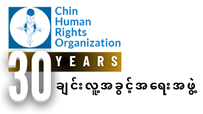VOL.V No.V NOVEMBER-DECEMBER 2002
Rhododendron News VOL.V No.V NOVEMBER-DECEMBER 2002 Human Rights: New Buddhist Pagoda Being Built in Chin State with Forced Labor Burmese Army on the Rampage of Extortion Refugees: District-wide Eviction Left Hundreds of Chin Refugees Shelterless in Mizoram Chin Refugees in Another District of Mizoram To Be Evicted in January 2003 Ignored Chin Refugees In
